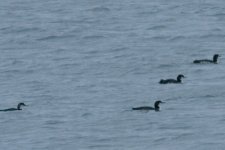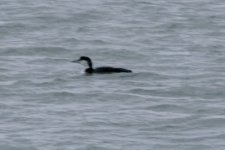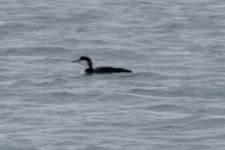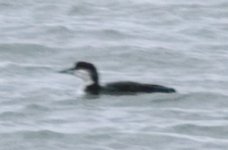-
Welcome to BirdForum, the internet's largest birding community with thousands of members from all over the world. The forums are dedicated to wild birds, birding, binoculars and equipment and all that goes with it.
Please register for an account to take part in the discussions in the forum, post your pictures in the gallery and more.
You are using an out of date browser. It may not display this or other websites correctly.
You should upgrade or use an alternative browser.
You should upgrade or use an alternative browser.
Are these Gt Northern Divers (1 Viewer)
- Thread starter Pluvius
- Start date
More options
Who Replied?Larry Sweetland
Formerly 'Larry Wheatland'
I'd still like to know why these aren't Pacific Divers (apart from range obviously), if anyone's on it. Don't think it's too untopical given the recent report.
timwootton
Well-known member
Hiya Graham - With regard to drawing species - that's very difficult, that's why I only attempt individuals (if you get my meaning). What I mean to say is that I observe an individual of a species and make my drawings of that single bird - that way I know what I'm seeing is honest and truthful (to me and to that particular individual, on that particular day) - I would hate to then have to make a 'standard' drawing of, say, winter plumage Great Northern Diver, because the variety across individuals can be quite striking. (Incidentally Lars Jonsson makes a similar reference in 'Birds and Light' with regard to making the 'standard' id painting of house sparrow, and he goes into some detail about the problems associated with this approach.)bitterntwisted said:OK, I'm happy that so many people of much greater experience agree on BTD, but I am now very confused. I presumed that the bold white flank patch and clean neck line were both necessary and sufficient conditions for ID of BTD, and that the absence of these meant GND. What about the other way round? Can a GND show a clear white rear flank patch and a clear neck line? (I hope not because that puts a line through one of my best ticks last year!)
This thread has put me back to square 1. Why, for example, is the bird in Tim's 2nd sketch a BTD. I had presumed the collar in the bottom left image to be diagnostic of GND?
If these characteristics are not crucial, what is? Head shape is variable in both species. There is (small) size overlap between species and when sea-watching size comparisons may be difficult or absent. So what is a reliable characteristic?
The point about sociability is a good and very useful one, but surely it would be rather petitio principii to use this as an ID clincher.
Summary: HELP!
Graham
But back to my drawings (or, from the sublime to the ridiculous, if you wish), it certainly helps to get to grips with Great Northern Diver winter plumage (and identifying the bird correctly) when one is lucky enough to have a handful in various plumages scattered across the bay - I was able to almost follow the moult progression of the species (in general terms) by looking from one bird, in almost full nuptial plumage, through several stages of moult and finally a bird in full winter attire. The black-throats were less distinctive (I don't know, but I assume they moult quicker??!!) and showed a more 'uniform' standard of dress, (although the residual striations along the side of the neck showed well on close observation) - except the juvs, which are distinctive because of the more finely scalloped backs and head pattern (the bird in the bottom right is a juv). But once again, it was really handy (cheers God) to have a small raft of them within 50 meters.
Returning to the original photo - if there was just a single bird in the frame I, for one, would be very reluctant to state which species I thought it to be as, from that distance, and in my experience, the two can look very similar. I think they're black-throated because of their habit, not because of any colour, pattern or jizz detail evident.
Cheers - Tim
hannu
Well-known member
Compare to this 2cy BtD
http://www.tarsiger.com/images/Markku/IMG_2381.jpg
http://www.tarsiger.com/images/Markku/IMG_2381.jpg
Big Phil
Well-known member
Larry Wheatland said:I'd still like to know why these aren't Pacific Divers (apart from range obviously), if anyone's on it. Don't think it's too untopical given the recent report.
I don't think its possible to tell from this photo. As I recall characters of (non-breeding) Pacific are the weaker bill, lack of flank patch and presence of a chinstrap.
timwootton
Well-known member
Hannu - No-one's going to mis-identify from such a fine picture (even me!) - it's just a that the original image we're trying to dissect is rather less informing. What do you think about the first photograph?hannu said:Compare to this 2cy BtD
http://www.tarsiger.com/images/Markku/IMG_2381.jpg
hannu
Well-known member
timwootton said:Hannu - No-one's going to mis-identify from such a fine picture (even me!) - it's just a that the original image we're trying to dissect is rather less informing. What do you think about the first photograph?
In my mind, e.g. the size of the bird and possibly the size of bill fits better to BtD...
Steve G
RAINBIRDER
I must admit, at the risk of making an @rse of myself I can't help feeling that at least some of these birds are Gt. N. Divers. In the most recent image at least 2 of these birds have the typical steep foreheads/ flat tops to the head with a crescentic white nick into the black of the neck -more typical of Gt.N.
The size/robustness issue is difficult to assess here.
The size/robustness issue is difficult to assess here.
Jane Turner
Well-known member
well if nothing else its proving a point I have made previously, but not on here, that BTD and GND are highly confusable!
deborah4
Well-known member
I'm inclined to stick to my original comments in post one (still without 100% conviction though!). These later pics show what I believe to be the 'thicker necks' and heavier bills/pattern of GND. The flat crowns are good, IMO, for GND. They are also swimming lower in the water, there is no obvious white flash visible. Although Tim's points are spot on generally (excellent field work Tim!), I don't think lack of 'sociability' is indicative enough to discount GND. Also their chests do not seem to 'protrude' forward enough to me. I also agree with Tim, that most of us wouldn't have trouble separating in the field, from Pics that aren't very clear (although these are much better), it's difficult (that should cover us!!!!)
Steve G
RAINBIRDER
Here is a cropped re-sized image of a juv. B.T.Diver to compare with one of Pluvius's images above: the forehead angulation is much less steep in B.T.D whilst the transition from white to black on the neck is much cleaner (linear) & less smudged.
Attachments
StuartReeves
Local rarity
This is an instructive photo of a group of Black-throated Divers: http://www.netfugl.dk/pictures.php?id=showpicture&picture_id=9259
Note how the apparent head-shape and division between the black and white varies with posture.
Stuart
Note how the apparent head-shape and division between the black and white varies with posture.
Stuart
Larry Sweetland
Formerly 'Larry Wheatland'
Blimey, I'm starting to think they could be Great Northern now. (I have seen GND in a group like that before btw, so they do sometimes do it !). How are we ever supposed to claim we can ID more similar birds from very subtle structural differences, when we're having such bovver off 2 spp as differently shaped as these ?
Thanks Big Phil for features of Pacific.
Thanks Big Phil for features of Pacific.
gerdwichers8
Well-known member
How the birds are in all examples situated in the water, high up and with their highest point noticeably positioned and their abrubt rearend, still holds very good for the species.
I do regard how tricky it can be but I must admit that they show a range of features really persistently.
GND does form parties in autumn but how that continues in winter;commonly they ll loose their familly group.
But how would their real norm show if numbers do increase? My country, more to the South and getting less birds, has a good year with them.
Ill see what is decided in the end.
I do regard how tricky it can be but I must admit that they show a range of features really persistently.
GND does form parties in autumn but how that continues in winter;commonly they ll loose their familly group.
But how would their real norm show if numbers do increase? My country, more to the South and getting less birds, has a good year with them.
Ill see what is decided in the end.
Last edited:
deborah4
Well-known member
Larry Wheatland said:How are we ever supposed to claim we can ID more similar birds from very subtle structural differences, when we're having such bovver off 2 spp as differently shaped as these ?
Birding in cr*ppy weather without a decent scope helps!

If it's any consolation Graham, I'm finding it very hard to call these divers with any certainty from these pictures alone, although the head shape in pretty much all is more convincing for GND to me. I don't know if I'm as experienced with divers as others here, but I've tended to notice that the more divers I see the more difficult they seem to get, especially when views are less than perfect.
Last edited:
Steve G
RAINBIRDER
GND is a fairly common winter species in hebridean waters (& is probably also in Ulster waters). A winter ferry trip to Mull or any of the other islands should yield a good number of sightings including birds in small groups. East coast birders more commonly encounter singelton GNDs.
The group/social issue doesn't help; assessing size/bulk is difficult in these images -I think it all boils down to our individual interpretations of head shape & neck pattern. I don't think I have seen anything in these images that would exclude GNDs.
From a behavioural aspect I have always found that GNDs 'periscope' MUCH more often than RTDs & BTDs -was this apparent Pluvius??
The group/social issue doesn't help; assessing size/bulk is difficult in these images -I think it all boils down to our individual interpretations of head shape & neck pattern. I don't think I have seen anything in these images that would exclude GNDs.
From a behavioural aspect I have always found that GNDs 'periscope' MUCH more often than RTDs & BTDs -was this apparent Pluvius??
Users who are viewing this thread
Total: 2 (members: 0, guests: 2)








